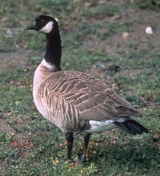
Aleutian Cackling Goose
Encyclopedia
The Aleutian Cackling Goose (Branta hutchinsii leucopareia), formerly known as the Aleutian Canada Goose
(Branta canadensis leucopareia), is small subspecies
of Cackling Goose
averaging 1700 to 2100 grams.
The †Bering Cackling Goose (Branta hutchinsii asiatica) is the name given to Cackling Geese on the Komandorski and Kuril Islands
. This population was not markedly distinct from the Aleutian one and is usually included with them. By about 1920 or so (last seen 1914 or 1929), these westernmost birds went extinct from persecution by humans and Arctic Fox
es.
The Aleutian Cackling Goose has the typical black head and neck, white cheek patches, grayish brown back and wings, white rump, black tail feathers, legs, and feet of the species. It is distinguished by a conspicuous white neck ring at the base of the neck that, in adult plumage, is usually greater than 10 mm wide and is subtended by a ring of darker feathers. The cheek patches are usually separated by a black line under the throat and the breast is a pale grayish-brown color, although a small number of lighter and darker breasted birds occur. The westernmost population did not appreciably differ in color, except that the neck ring was always very wide and white in the few attested specimens.
Similar in appearance is the Small Cackling Goose (B. h. minima) which is smaller in size and have a dark breast color with a purplish or brownish cast whereas Taverner's Cackling Geese (B. h. taverneri) are larger and have a lighter breast color. Both minima and taverneri sometimes have white neck rings but these are usually narrow or indistinct.
The primary threat to the Aleutian Cackling Goose has been the Arctic Fox
, introduced to the Aleutian Islands by Russian fur traders between 1836 and 1930. The Cackling Canada Goose was considered extinct until a colony was discovered on Buldir Island in 1962. Since then, the Aleutian Cackling Goose has made a comeback and was removed from the endangered species list in 2001.
Canada Goose
The Canada Goose is a wild goose belonging to the genus Branta, which is native to arctic and temperate regions of North America, having a black head and neck, white patches on the face, and a brownish-gray body....
(Branta canadensis leucopareia), is small subspecies
Subspecies
Subspecies in biological classification, is either a taxonomic rank subordinate to species, ora taxonomic unit in that rank . A subspecies cannot be recognized in isolation: a species will either be recognized as having no subspecies at all or two or more, never just one...
of Cackling Goose
Cackling Goose
The Cackling Goose is a North American bird of the genus Branta of black geese, which contains species with largely black plumage, distinguishing them from the grey Anser species....
averaging 1700 to 2100 grams.
The †Bering Cackling Goose (Branta hutchinsii asiatica) is the name given to Cackling Geese on the Komandorski and Kuril Islands
Kuril Islands
The Kuril Islands , in Russia's Sakhalin Oblast region, form a volcanic archipelago that stretches approximately northeast from Hokkaidō, Japan, to Kamchatka, Russia, separating the Sea of Okhotsk from the North Pacific Ocean. There are 56 islands and many more minor rocks. It consists of Greater...
. This population was not markedly distinct from the Aleutian one and is usually included with them. By about 1920 or so (last seen 1914 or 1929), these westernmost birds went extinct from persecution by humans and Arctic Fox
Arctic fox
The arctic fox , also known as the white fox, polar fox or snow fox, is a small fox native to Arctic regions of the Northern Hemisphere and is common throughout the Arctic tundra biome. The Greek word alopex, means a fox and Vulpes is the Latin version...
es.
The Aleutian Cackling Goose has the typical black head and neck, white cheek patches, grayish brown back and wings, white rump, black tail feathers, legs, and feet of the species. It is distinguished by a conspicuous white neck ring at the base of the neck that, in adult plumage, is usually greater than 10 mm wide and is subtended by a ring of darker feathers. The cheek patches are usually separated by a black line under the throat and the breast is a pale grayish-brown color, although a small number of lighter and darker breasted birds occur. The westernmost population did not appreciably differ in color, except that the neck ring was always very wide and white in the few attested specimens.
Similar in appearance is the Small Cackling Goose (B. h. minima) which is smaller in size and have a dark breast color with a purplish or brownish cast whereas Taverner's Cackling Geese (B. h. taverneri) are larger and have a lighter breast color. Both minima and taverneri sometimes have white neck rings but these are usually narrow or indistinct.
The primary threat to the Aleutian Cackling Goose has been the Arctic Fox
Arctic fox
The arctic fox , also known as the white fox, polar fox or snow fox, is a small fox native to Arctic regions of the Northern Hemisphere and is common throughout the Arctic tundra biome. The Greek word alopex, means a fox and Vulpes is the Latin version...
, introduced to the Aleutian Islands by Russian fur traders between 1836 and 1930. The Cackling Canada Goose was considered extinct until a colony was discovered on Buldir Island in 1962. Since then, the Aleutian Cackling Goose has made a comeback and was removed from the endangered species list in 2001.

